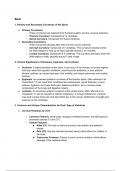Back
1. Primary and Secondary Curvatures of the Spine
● Primary Curvatures:
○ These curvatures are retained from the fetal position and are concave anteriorly.
○ Thoracic Curvature: Composed of 12 vertebrae.
○ Sacral Curvature: Composed of 5 fused vertebrae.
● Secondary Curvatures:
○ These curvatures develop after birth and are convex anteriorly.
○ Cervical Curvature: Composed of 7 vertebrae. This curvature develops when
the infant begins to hold up its head, typically around 3 to 4 months.
○ Lumbar Curvature: Composed of 5 vertebrae. This curvature develops when the
child begins to walk, typically around 1 year of age.
2. Clinical Significance of Scoliosis, Kyphosis, and Lordosis
● Scoliosis: A lateral deviation of the spine. It can occur in the thoracic or lumbar regions
and may result from genetic conditions, neuromuscular problems, or poor posture.
Severe scoliosis can cause back pain, limit mobility, and impact pulmonary and cardiac
function.
● Kyphosis: An excessive posterior curvature of the thoracic spine, often referred to as
"hunchback." It can result from conditions like osteoporosis, spinal fractures, or poor
posture. Kyphosis can cause back pain, balance problems, and, in severe cases,
compression of the lungs and digestive organs.
● Lordosis: An excessive anterior curvature of the lumbar spine, often referred to as
"swayback." It can be caused by obesity, pregnancy, or muscle imbalances. Lordosis
may lead to lower back pain and discomfort due to the uneven distribution of weight and
pressure on the vertebrae.
3. Common and Unique Characteristics for Each Type of Vertebrae
● Cervical Vertebrae (C1-C7):
○ Common Features: Small body, triangular vertebral foramen, and bifid spinous
processes (except C1 and C7).
○ Unique Features:
■ Atlas (C1): No body or spinous process; has anterior and posterior
arches.
■ Axis (C2): Has the odontoid process (dens) which allows for rotation of
the head.
■ Transverse Foramen: Present in each cervical vertebra, which allows
passage of the vertebral artery.
, ● Thoracic Vertebrae (T1-T12):
○ Common Features: Larger bodies than cervical vertebrae, round vertebral
foramen, and long spinous processes that point inferiorly.
○ Unique Features: Costal facets on the body and transverse processes for
articulation with the ribs.
● Lumbar Vertebrae (L1-L5):
○ Common Features: Largest bodies to support weight, triangular vertebral
foramen, and thick, short spinous processes.
○ Unique Features: The absence of transverse foramina and costal facets. The
orientation of the articular facets allows for flexion and extension but limits
rotation.
4. Contents of Vertebral Foramen, Intervertebral Foramen, and Transverse Foramen
● Vertebral Foramen: Contains the spinal cord, meninges, spinal nerve roots, blood
vessels, and fat.
● Intervertebral Foramen: Passageway for spinal nerves as they exit the vertebral
column, along with blood vessels.
● Transverse Foramen (Cervical Vertebrae): Contains the vertebral artery and vein,
which supply blood to the brain.
5. Clinical Significance of the Hangman Fracture
● Hangman Fracture: A fracture of the pars interarticularis of the axis (C2). This type of
injury is typically caused by hyperextension and is associated with severe trauma. If not
treated properly, it can lead to instability and damage to the spinal cord.
6. Function of the Intervertebral Disc and Herniation
● Intervertebral Disc: Acts as a shock absorber between the vertebrae and allows
flexibility of the spine. It consists of the annulus fibrosus (outer fibrocartilaginous ring)
and the nucleus pulposus (inner gelatinous core).
● Disc Herniation: Occurs when the nucleus pulposus protrudes through a weakened
area of the annulus fibrosus, often compressing spinal nerves. The most common site
of herniation is between L4-L5 or L5-S1.
7. Location and Function of the Muscles
● Trapezius: Located in the upper back and neck, it helps in elevating, retracting, and
depressing the scapula.
● Latissimus Dorsi: Located in the mid to lower back, it adducts, extends, and internally
rotates the arm.
● Levator Scapula: Located along the side of the neck, it elevates the scapula.




